Sida hermaphrodita (L.) Rusby
Sida hermaphrodita (L.) Rusby, Sida for short, is a perennial herbaceous plant of the mallow family (Malvaceae) native to the east coast of North America. Sida develops numerous stems up to 250 - 350 cm long. The round stems are initially light green, reach a diameter of about 15 - 20 mm and are branched in the upper part.
From the second to third year, a robust shrub with 8-12 stems and a well-developed root system emerges. From the end of June to the end of September, new white flowers keep forming, which are available as food resources for flower-visiting insects.
At the end of the growing season, the leaves fall off and hard, pithy, brown stems with a low moisture content remain in the field.
Sida has low soil requirements and grows even in marginal arable land. The plants with strong root systems can also easily withstand intermittent drought and winter cold down to - 35°C. According to JABLONSKI and KOLTOWSKI (2004), Sida prefers warmer, wind-protected sites. Extremely acidic or very stony soils and soils with waterlogging are unsuitable (USTAK, 2008).
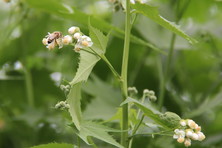
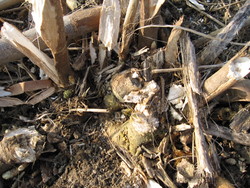
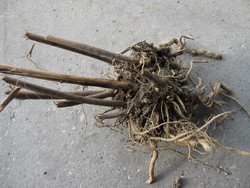
Raw material production
Stand establishment / crop management
In Austria, there is already sporadic practical experience with Sida. In recent years, the first pioneers have established some stands in Lower Austria, Upper Austria and Styria. Currently, the establishment of stands is almost entirely carried out by planting out pre-sprouted seedlings, which is very cost-intensive. According to USTAK (2008), seeding is also possible, with spring (mid to late April) or fall (late October to early November) seeding.
However, experience has shown that practical seeding is not practicable to date due to seed qualities that have not yet been optimized or are lacking (HÖLLER, 2012). REMLEIN-SAROSTA and NIJDAK (2007) see the problem in the often poor germination capacity. Therefore, pretreated seed is needed to improve field emergence.
Due to slow seedling development, intensive mechanical weed control (between and within rows) is necessary in the first year. In case of heavy weediness by grasses (couch grass), chemical weed control is recommended. From the 2nd year of vegetation, weed control is no longer necessary (USTAK, 2008; HÖLLER, 2012). The plants are only slightly susceptible to diseases and pests (BORKOWSKA et al., 2009; HÖLLER, 2012).
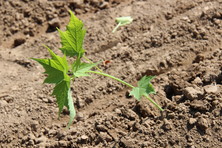
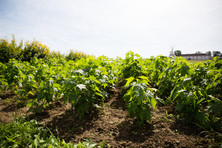
Harvesting
Harvesting is carried out using conventional corn harvesting technology (forage harvester with row-independent cutterbar). The harvesting time has a significant influence on the biomass properties and determines the further energetic use.
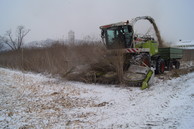
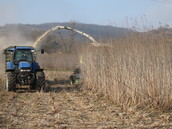
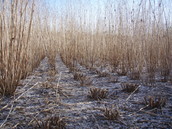
Preparation
In general, preparation of stalk-type biomass into pellets is possible, but no experience is yet available for Sida. In general, mechanical preparation steps such as proper size reduction and compacting can significantly improve the fuel properties.
Favorable dosing, low dust emissions, high boiler efficiency, and trouble-free operation with a high degree of utilization are most likely to be achieved with pelletized, highly standardized fuels.
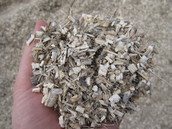
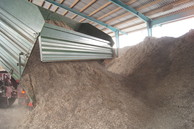
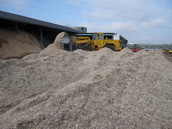
Potential of the raw material
In coordination with management, there are many possible uses for the Sida biomass. Among others, the biomass can be used for the production of biofuels, as a raw material for biogas production, for thermal use, in the cellulose industry, as a source for the pharmaceutical industry, and as an insulating material (BORKOWSKA et al., 2006).
In Europe and Russia, Sida is already widely used. In Poland and Russia, among others, Sida is planted to obtain biomass for the pulp and paper industry (THOMPSON-BLACK and HABER, 2010).
Sida is particularly characterized by its high biomass yield potential over many years. According to BORKOWSKA et al. (2006), the plant can be used for 15 to 20 years and even 20 to 25 years according to USTAK (2008). On good soils, dry matter yields of 15 t/ha can easily be achieved. No reliable results are yet available on the biomass yield potential in Austria.
Potential as raw material for thermal utilization
For use as fuel, harvesting occurs once a year after the end of the growing season (USTAK, 2008). The goal is to have the driest possible biomass. SZYSZLAK et al. (2006) give an average calorific value of 16.627 MJ kg-1 for woody above-ground plant parts. BORKOWSKA et al. (2009) elicited a heating value of 18.746 MJ kg-1.

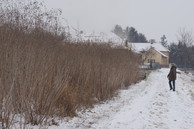
Potential as a raw material for biogas production and bioalcohol production.
When used as a substrate for biogas and bioalcohol production, Sida is harvested when green Harvesting can take place two to three times a year (end of June; mid-September) from the second year of vegetation.
No results are yet available on the yield.
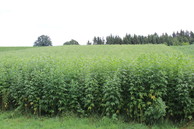
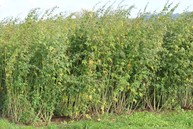
Bibliography and sources
BORKOWSKA H., B. STYK und R. MOLAS (2006): Staude mit Potential, Sida als Energie- und Faserpflanze. In: Energiepflanzen II/2006, S.12-13. BORKOWSKA H., R. MOLAS und A. KUPCZYK (2009): Virginia Fanpetals (Sida hermaphrodita (L.) Rusby) Cultivated on Light Soil; Height of Yield and Biomass Productivity. Polish J. of Environ. Stud. Vol. 18, No. 4 (2009), 563-568. CARVALHO L., E. WOPIENKA, C. POINTNER, J. LUNDGREN, V.K. VERMA, W. HASLINGER und C. SCHMIDL (2013): Performance of a pellet boiler fired with agricultural fuels. Applied Energy. 104:286–96. FELDWISCH N. (2011): Umweltgerechter Anbau von Energiepflanzen. Schriftenreihe des LfULG, Heft 43/2011. HÖLLER M. (2012): Persönliche Mitteilung am 03.09.2012. JABLONSKI B. und Z. KOLTOWSKI (2004): Nectar secretion and honey potential of honey-plants growing under polland`s conditions – Part XV. Journal of Apicultural Science, Vol. 49 No. 1, 2005. REMLEIN-SAROSTA D. und K. NIJDAK (2007): Virginia mallow the first results of investigation on possibilities of pest and diseases control. Progress in Plant Protection / Postępy w Ochronie Roślin, 47 (4). SZYSZLAK J., W. PIEKARSKI, P. KRZACZEK und H. BORKOWSKA (2006): Analysis of possible utilization of virginia Mallow for energy purposes. Insynieria Rolnicza 6/2006. THOMPSON-BLACK M.J. und E. HABER (2010): Assessment and status report on the Virginia Mallow Sida hermaphrodita in Canada. Cosewic. Committee on the Status of Endangered Wildlife in Canada, Ottawa. ix + 18 pp. (www.sararegistry.gc.ca/status/status_e.cfm). USTAK S. (2008): Pestování a využití vlákne oboupohlavné v podmínkách Ceské republiky Výzkumný ústav rostlinné výroby, v.v.i., ISBN 978-80-87011-74-4.
Project short description
As part of the SIDecA project, aspects along the entire value chain of this plant - from seed development and crop management to raw material processing and the investigation of various energy utilization options - are now being processed and economically evaluated.
The central objective of the project is to provide a competitive raw material and to develop optimal utilization scenarios for energy recovery in the form of thermal energy as well as conversion to bioethanol or biogas. Attractiveness, affordability and competitiveness of Sida as a new sustainable energy source will be increased by optimized stand establishment, utilization-optimized crop management and increase of energy density.
The production of a raw material that is adapted to the various energy use options enables the maximum energy yield to be exploited.
Project data
Research topic: Sustainable crop production Acronym: SIDecA (Intelligent Densified Energy Carriers for Austria) Project duration: 04/2014 - 03/2017 Project management: DDI Dr. Markus Gansberger/AGES Funding body/funding program: Climate and Energy Fund (FFG) / e!MISSION.at - 4th call for proposals.
This project is funded by the Climate and Energy Fund and carried out within the program "ENERGY MISSION AUSTRIA".


Project partner
- Austrian Agency for Health and Food Safety GmbH
- Bioenergy 2020+ Ltd.
- Wood Research Austria
- University of Natural Resources and Applied Life Sciences Vienna
- Gilles Energy and Environmental Technology GmbH & Co KG
- Ing. Aigner Water-Heat-Environment-GmbH
- SCM production and distribution GmbH
- Horticulture Michael Höller








The "SIDecA" project team
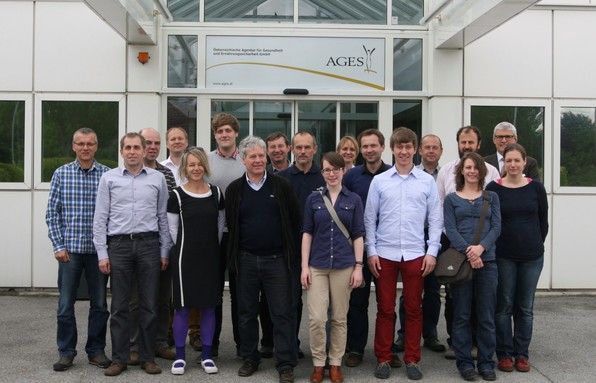
Not on the photo: Peter Liebhard (BOKU), Andreas Ratzenböck (AGES), Siegfried Aigner (AIGNER), Roswitha Höller (HÖLLER), Günther Bochmann (BOKU), Rudolf Moosbeckhofer (AGES), Charlotte Leonhardt (AGES)
Project goals "SIDecA
Thecentral objective of the project is to provide a competitive raw material and to further develop existing methods and processes for energy recovery.
An objective of the consortium is also the development of an interdisciplinary research competence (science + industry), which results from the holistic approach.
The specific objectives and expected results are:
Reduction of the production costs of the Sida raw material through seeding.
- A high quality seed (germination > 75%) for a time- and cost-saving stand establishment by sowing with a conventional precision seeder
Utilization-optimized establishment and crop management
- An optimized, cost-efficient crop management concept adapted to utilization
- Provision of the raw material with adapted properties for further use
Optimization of sida biomass treatment processes to increase energy density and improve properties for thermal utilization
- Optimized process regime for biomass preparation into fuel pellets - findings regarding necessary process energies, achievable energy density, logistics and storability of the biomass
- Mobile pelleting possible (in the field)
- Economic comparison between stationary and mobile pelletization
Identification of technological requirements to improve the applicability of Sida for thermal utilization
- Evaluation result of the applicability of Sida as fuel for small combustion plants
- Identification of possible technological requirements
Production of efficiently usable secondary energy sources from the optimized Sida raw material
- Achievement of the highest possible bioalcohol yield by identification of the best digestion process
- Yields in pure ethanol fermentation and ABE fermentation
- Development of a perennial raw material - especially for biogas production
- Holistic, energetic application variations (including cascading use; recycling of nutrients) + determination of their potentials
- Demonstration of the continuous fermentation of Sida and its influence on the continuous biogas process
Economic evaluation of the different utilization paths of Sida as an energy crop
- Economic key figures on the production process of Sida and different end uses as energy raw material
- Action matrix - which use makes economic sense for which environmental conditions
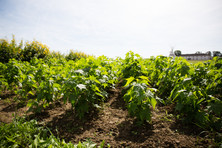
Stand establishment by seed
Philipp von Gehren, Markus Gansberger, Josef Mayr Austrian Agency for Health and Food Safety GmbH (AGES), Institute for Seeds and Seedlings, Plant Protection Service and Bees, Spargelfeldstraße 191, A-1220 Vienna www.ages.at
In crop production, a uniform and closed stand is a basic requirement for a successful and high-yielding harvest. Currently, stand establishment of S. hermaphrodita is usually done by a cost- and labor-intensive outplanting of seedlings pre-grown in the greenhouse. In rare cases, cultivation using root cuttings is also reported. Stand establishment by seeding could significantly reduce cost, labor, and material requirements, thus increasing the competitiveness of S. hermaphrodita relative to established energy crops. This requires the provision of a purified seed that is highly germinable and applicable with conventional seeding technology. The Institute for Seeds and Seedlings, Plant Protection Service and Bees of the AGES GmbH dealt with the realization of these tendered project goals in the project SIDecA. First, the germination behavior of S. hermaphrodita seeds was investigated in detail in multi-stage laboratory trials. A pronounced dormancy was observed in freshly harvested seeds, which prevented a uniform and rapid field emergence. By testing a wide variety of pretreatment measures, a pronounced hard-shelledness of the seeds was identified as the main cause of low germination. A tailored pretreatment of the seeds achieved a multiple increase in germination. Building on the findings on germination behavior obtained in the laboratory trials, a randomized sowing trial in a split-plot design was set up in 2016. This replicated the results obtained in the laboratory, so that pretreatment of the seed is highly recommended for stand establishment by sowing. The field trial also provided valuable insights into the sowing technology to be used and the optimum sowing time. At the end of the sowing trial, depending on the trial parameters applied, there was a satisfactory stand with tall plants, some of which were already flowering. It remains to be seen to what extent the yield figures will behave in the coming cultivation years.
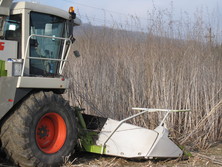
Optimization of raw material production
Harald Bock, Johannes Hösch Austrian Agency for Health and Food Safety GmbH (AGES), Institute for Sustainable Plant Production, Spargelfeldstraße 191, A-1220 Vienna www.ages.at,www.gaertnerei-am-berg.at
S. hermaphrodita as a perennial plant provides consistently usable yields of green or woody biomass over 10-15 crop years if well managed. In this context, various parameters such as stand density, planting date, harvest date, fertilization, and crop protection have a considerable influence on the yield to be harvested. The provision of a competitive raw material for downstream energetic utilization, adapted to the type of utilization, was the core task of work package 2, which was carried out by the Institute for Sustainable Plant Production of AGES GmbH in cooperation with the Department of Crop Sciences, BOKU and the horticulturalist Michael Höller. The influence of the crop density as well as the harvesting strategies adapted to the respective utilization scenario on the yield to be obtained was determined by means of a specially designed partially randomized field trial in a split-plot design. The experimental field is located at the AGES GmbH experimental station Grabenegg (Lower Austria) in the semi-humid climate zone. In 2014, three plots of 150 m2 each were established with three different planting associations (1.33, 1.77 and 2.66 plants/m2). In addition, established stands at the Großweikersdorf site (Lower Austria) are sampled to test the influence of age and location. Due to the dense growth of S. hermaphrodita, chemical plant protection measures could be completely omitted, only in the year of stand establishment it is recommended to give the freshly planted seedlings an advantage by manual weed control. In order to compensate for the nutrient withdrawal, 70 kg/ha of nitrogen were fertilized in spring. Depending on the energy recovery, the harvest strategy was adjusted. Woody biomass with low water content for thermal utilization was harvested in late January/early February. Green, fresh biomass for biogas and bioethanol production was cut twice a year: first in June, and another time in October. The primary goal of the work package was to achieve maximum energy yield through optimized feedstock production. In this context, harvesting in the year of cultivation proves to be economically unviable, as only low yields per hectare can be harvested. At this time, plant protection measures in particular must be carried out conscientiously in order to create a robust stand for the following 10-15 years of cultivation. Once established, the stands produced stable yields of between eight and ten tons of dry matter per hectare in the crop years. However, the planting density of 1.33 plants/m2 lagged significantly behind the other two planting densities. Whether the yields are symptomatic of the present climatic region, and how they behave in subsequent crop years, remains to be seen.
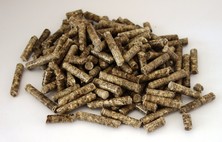
Fuel characterization and pelleting
Wilfried Pichler, Valerie Minihold Holzforschung Austria (HFA) , Franz Grill-Straße 7, A-1030 Vienna www.holzforschung.at
In work package 3, the potential of Virginia mallow - Sida hermaphrodita (L.) Rusby is investigated and evaluated with respect to mechanical processing and thermal utilization. Raw materials from 3 different locations will be chemically characterized, partially pelletized and tested for their combustion properties. In order to generate a practical process sequence for this new energy crop, the different process steps in the pelleting process were designed variably, such as different drying regimes, comminution techniques, different pressing technologies (ring die press and flat die press), .... Reference trials with other feedstocks (e.g. willow, miscanthus) serve a qualitative classification in comparison to already researched alternative fuels. The results of the tests in the biomass pilot plant of Holzforschung Austria show that pelleting of Sida is possible under similar conditions as for coniferous wood, although the process course is subject to greater variability. A small amount of drying of the feedstock is usually required, but may not be necessary at all if harvesting conditions are favorable. The roller mill has proven to be a favorable size reduction technology, since pre-compaction of the material takes place here at the same time. For pelletizing, it was found that the best process flow can be achieved on the flat die plant with a die size below 30 mm. The finished pellets have very good mechanical strength when properly processed, and an ash content of about 3%, the ash melting behavior and the content of nitrogen and chlorine are in a favorable range, the dependence of the nitrogen content on fertilizer intensity has not yet been investigated. A final evaluation of Sida as a fuel will be made in the last year of the project, taking into account all analytical results. The data so far suggest that Sida is a very promising raw material for fuel production. The full potential of the energy plant Sida is still in the development stage, and cannot yet be fully determined.
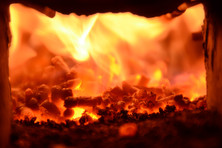
Potential for use as fuel
Elisabeth Wopienka, Sabine Feldmeier, Manuel Schwabl BIOENERGY2020+ GmbH, Gewerbepark Haag 3, A-3250 Wieselburg http://www.bioenergy2020.eu,www.gilles.at
The fuel composition of pellets not produced from bark-free softwood can be a problem for many combustion plants. The key challenges are therefore dealing with the formation of slag and deposits, increased risk of corrosion, and higher emission levels - which can be fuel-related (SO2, NOx, HCl), but also as a result of non-optimized combustion control of the plant (CO).
Within the SIDecA project, the potential of Sida as a fuel was addressed. Specifically, the applicability of Sida pellets in small combustion plants was investigated and initial practical operating experience gained. The raw material Sida proved to be plant-friendly, as no significant slagging tendency could be detected despite the relatively high ash content of the fuel. The results of these trials serve as a basis for evaluating the general suitability as a fuel for small combustion plants. From the test results, basic technological requirements can be derived - especially in the area of ash management and emissions. Reference tests with other raw materials (e.g. willow, miscanthus) serve as a first qualitative classification of Sida in comparison to already researched alternative fuels.
The measured NOx emissions when operating with Sida would meet the current legal requirements. The dust emissions are comparable to the dust emissions when operating with pellets from short rotation (pasture). The data so far suggest that Sida is a very promising feedstock for fuel production.
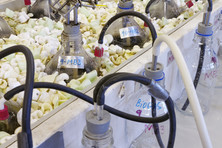
Biogas and Biomethane
Lucy Montgomery, Ludek Kamarad, Lorenz Miller, Günther Bochmann University of Natural Resources and Life Sciences Vienna, Institute of Environmental Biotechnology, Konrad-Lorenz-Straße 20, A-3430 Tulln an der Donau http://www.boku.ac.at,http://www.ing-aigner.at
Biogas is currently produced in Austria mainly by the fermentation of corn silage and liquid manure. Other energy crops such as grass or rye are also used. Like corn, the fresh biomass of the Sida plant can also be ensiled and fermented into biogas. The environmental benefits of a flowering perennial plant, like Sida, make it a good substitute biogas substrate instead of corn.
The Institute of Environmental Biotechnology (BOKU) investigated how much methane can be extracted from the sida crop that was harvested twice a year (once in June, and another time in October). For this purpose, biomethane potential tests were conducted with a duration of 35 days.
The results show that the Sida biomass harvested in June produces the same amount of methane as corn silage. October harvested biomass produces 12% less methane. On average, the biomethane potential is 312 Nl/kg oTS. Difficulties have been noted with agitation in the biogas reactor. Long, strong fibers could not be decomposed and interfered with the agitation process.
Trials are currently ongoing to measure the bioethanol potential of the Sida plant and the influence of stand density on methane yield.
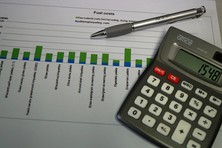
Sida as an energy source - can it pay off?
Michael Eder, Thomas Wilflingseder University of Natural Resources and Life Sciences (BOKU), Institute of Agricultural and Forestry Economics, Feistmantelstraße 4, A-1180 Vienna http://www.boku.ac.at
After extensive investigations and optimization trials by the participating project partners in the areas of stand establishment, cultivation technology, processing and utilization of biomass, the Institute of Agricultural and Forestry Economics at the University of Natural Resources and Applied Life Sciences, Vienna, is addressing the question of which utilization paths could be most promising economically. On the basis of different planting and harvesting dates as well as crop densities, the evaluation of economic viability is carried out in the form of a calculated annual contribution margin. For the fermentation of biomass in biogas plants, the cost per cubic meter of methane is another measure of economic viability. In the area of transport logistics, it should be noted that in this form of utilization with harvesting twice a year, high volumes with low bulk density have to be handled, combined with the question of the maximum distance between the field and the biogas plant for a minimum level of economic efficiency. Biomass processed in the form of pellets establishes the utilization path for thermal recovery. Two fundamentally different processes are considered: mobile pelletizing at the field by means of energy harvesters and stationary pelletizing, as also used for the production of wood pellets. In the latter process, additional economies of scale - by including model plants of different sizes in the calculations - are taken into account. The necessary transport logistics also play a central role in this area. It can already be seen in advance that marketing Sida pellets as regionally as possible will be indispensable from an economic point of view.
Last updated: 20.11.2023
automatically translated